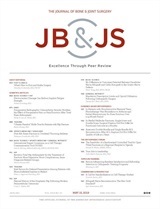
Trauma
Omitting x-rays after the 2-week mark is non-inferior to routine imaging in distal radius fractures
J Bone Joint Surg Am. 2019;101:1342-1350. 10.2106/JBJS.18.01160Distal radius fractures are at risk of failed reduction following either operative or non-operative treatment. For this reason, many surgeons routinely perform repeated radiographs throughout the follow-up period. It is unclear, however, whether more frequent imaging actually affects management or outcomes. Thus. the authors randomized 386 patients to routine care (X-rays at 1, 2, 6, and 12 weeks) or reduced imaging (X-rays at 1 and 2 weeks). Outcomes were the Disabilities of the Arm, Shoulder and Hand (DASH) score. Secondary outcomes were the Patient-Rated Wrist/Hand Evaluation (PRWHE), EuroQol-5D (EQ-5D), Short-Form 36 (SF-36), Visual Analogue Scale (VAS) for pain and health status. There were no significant differences between the two groups in terms of DASH score, EQ-5D, PRWHE, or VAS pain or health satisfaction. Complication rate was similar between the two groups. Overall, fewer radiographs were taken of the patients in the intervention group with no other significant differences.
Unlock the full article
Get unlimited access to OrthoEvidence with a free trial
Start TrialCritical appraisals of the latest, high-impact randomized controlled trials and systematic reviews in orthopaedics
Access to OrthoEvidence podcast content, including collaborations with the Journal of Bone and Joint Surgery, interviews with internationally recognized surgeons, and roundtable discussions on orthopaedic news and topics
Subscription to The Pulse, a twice-weekly evidence-based newsletter designed to help you make better clinical decisions
Exclusive access to original content articles, including in-house systematic reviews, and articles on health research methods and hot orthopaedic topics
Or continue reading this full article
Register Now

Subscribe to "The Pulse"
Evidence-Based Orthopaedics direct to your inbox.




































